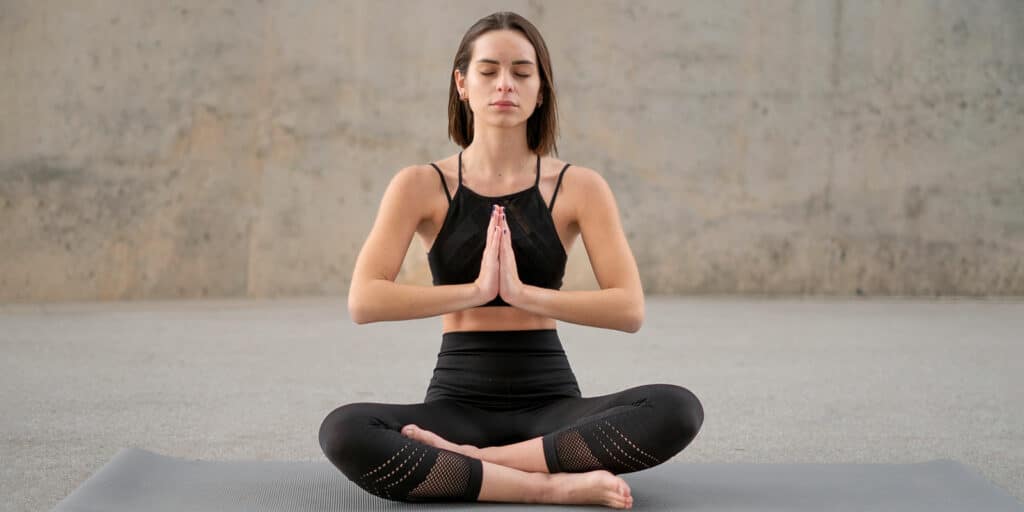Factors to Consider During Pranayama
by Soha Akbar

Friends, in the previous blog, we talked about a basic understanding of pranayama as per different texts. Today we’ll take a look at some important factors one should consider when practising pranayama. Let’s see what they are.
Time of practice: Dawn is the best time to practise pranayama because both the body and mind are fresh. Practising during Brahma muhurta, which is around one and a half hours before sunrise, is also greatly beneficial. The next best option is just after sunset. It is advisable to practice at the same time daily.
पराणायामं ततः कुर्यान्नित्यं सात्त्विकया धिया |
यथा सुष्हुम्णा-नाडीस्था मलाः शुद्धिं परयान्ति छ ||
(Hatha Yoga Pradipika)
Pranayama should be done daily with a sattvic state of mind so that the impurities are driven out of the sushumna nadi and purification occurs.
Place of practice: It should be calm, clean and properly ventilated. Practising outside at dawn under the rays of the morning sun is beneficial. However, refrain from practising under direct sunlight at other times of the day as it may overheat the body. Again, practising in the same place daily is better.
Sequence of practice: Traditionally, it is advised that pranayama be performed after shatkarmas and asanas, and before meditation. Shatkarmas cleanse us internally, the excess vata, pitta and kapha get removed from the body, all the stagnant blood and blockages from the respiratory and digestive passages are removed, thus allowing for a smooth and unobstructed flow of pranic energy. As for asanas, they tone and strengthen the body, make us capable of sitting steadily in pranayama for longer durations, and improve alertness, focus and balance, thus preparing us to gain the maximum benefits of pranayama. However, if one has strengthened the body and mind by a regular asana practice, he or she may directly perform pranayama.
Nowadays we attend yoga classes at different times of the day. So, when can pranayama be practised in this scenario? In a yoga class, pranayama is usually practised at the end of the session. Personally, after the asana practice is over, I find Shavasana to be a good segue into pranayama. After all the challenging movements of the asanas, Shavasana helps us relax completely, inducing a quiet stillness in the body and mind, while being aware of the breath. This state of calmness is a good preparation for pranayama.
अथासने दॄधे योगी वशी हित–मिताशनः |
गुरूपदिष्ह्ट–मार्गेण पराणायामान्समभ्यसेत ||
(Hatha Yoga Pradipika)
Being established in asana and having control (of the body), taking a balanced diet; pranayama should be practised as per the guru’s instructions.
Posture: One should sit in any comfortable meditative posture to enable efficient breathing during the practice. It should be such that the practitioner is able to sit steady in the posture throughout the duration of the practice. People who are unable to sit in meditative postures due to medical reasons may sit in a chair with a straight back.
Clothes: Comfortable and loose clothes made with natural fibres are the best, as they allow the practitioner to sit comfortably for a long duration and let the skin breathe. Such clothes are also conducive to proper prana circulation throughout the body.
Bathing: It is advisable to take a bath before practice, because it is an indicator of external purity, one feels fresh since the laziness goes away, and the nerves are stimulated and active. However, do not take a bath for at least half an hour after the practice, in order to normalize the body temperature.
Diet: A well-balanced, sattvic diet is recommended, as it is easily digested and does not make the body and mind sluggish.
Empty stomach: Pranayama should be practised before eating in the morning. Alternatively, it can be practised after waiting for at least three to four hours after meals, since a stomach full of food puts unnecessary pressure on the lungs and diaphragm, making deep respiration difficult.
Avoid strain: It is important to advance the practice gradually over a period of time, and not try to increase your capacity too fast. Misusing the lungs can cause damage or injury.
Contra-indications: As a general rule, one should refrain from practising pranayama during illness, although simple techniques such as breath awareness can be performed. It is useful to carefully observe the contra-indications of each pranayama practice to understand it better.
पराणायामेन युक्तेन सर्व-रोग-कष्हयो भवेत |
अयुक्ताभ्यास-योगेन सर्व-रोग-समुद्गमः ||
(Hatha Yoga Pradipika)
By proper practice of pranayama etc., all diseases are eradicated. Through improper practice, all diseases can arise.
Side-effects: Once we start practising pranayama regularly, it will lead to the expulsion of toxins from the body. The process of purification may give rise to certain symptoms in normally healthy practitioners. Some of these symptoms include itching, tingling, hot or cold sensations and feelings of lightness or heaviness in the body. Keep your yoga teacher informed of these variations. If these symptoms persist and affect your lifestyle adversely, please cease your practice until you can get in touch with a competent teacher.
As Hardik Mehta from Sayujya Yoga says: Breath regulation can have a positive impact on our overall health and well-being. Humans can survive 3 weeks without food, 3 days without water, but only 3 minutes without breathing. Yet, we don’t give enough importance to proper breathing. Increased stress, anxiety and tension can result in short and shallow breathing. When our breath is deep and mindful, our fight and flight mechanism is switched off and our rest and digest mode is switched on.
Now that we have discussed the factors to consider when practising pranayama, we shall look at the important aspects of breathing, and the concept of mudras and bandhas associated with pranayama in the next blog. Till then, if you are on the lookout for a good Yoga Alliance course in Mumbai, do check out the 200 hours Yoga training from Sayujya Yoga.
About the Author

Sohaila Akbar
Sohaila is a Yoga teacher, keen on bringing about positive changes in the lives of others through the knowledge that she has received from her teachers. Prior to this she was a school teacher working towards imparting academic, social and ecological knowledge to young learners. Sohaila is an avid reader of books and have an undying love for fiction. She prefers paperbacks and hardcovers over e-books anyday. She loves travelling, and a good cup of coffee is always welcome!
